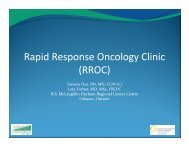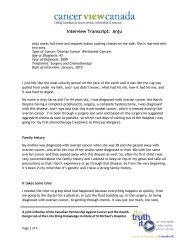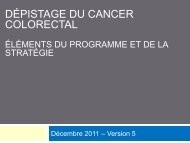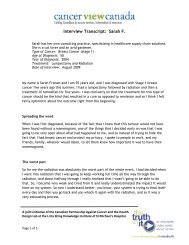A Guide to Implementing Best Practices in Person ... - cancerview.ca
A Guide to Implementing Best Practices in Person ... - cancerview.ca
A Guide to Implementing Best Practices in Person ... - cancerview.ca
Create successful ePaper yourself
Turn your PDF publications into a flip-book with our unique Google optimized e-Paper software.
Navigation: A <strong>Guide</strong> <strong>to</strong> <strong>Implement<strong>in</strong>g</strong> <strong>Person</strong>-Centred Care September 2012Functions with<strong>in</strong> each competency <strong>ca</strong>n similarly be tailored <strong>to</strong> reflect:• Components of the <strong>in</strong>dividual role (e.g., work <strong>in</strong> the community or cl<strong>in</strong>i<strong>ca</strong>l sett<strong>in</strong>g)• Resources and services• Individual role descriptionsRegardless of professional background, a professional <strong>ca</strong>ncer naviga<strong>to</strong>r must possesscl<strong>in</strong>i<strong>ca</strong>l expertise <strong>in</strong> oncology, have highly developed therapeutic communi<strong>ca</strong>tion andproblem-solv<strong>in</strong>g skills, and have a broad knowledge of the health <strong>ca</strong>re system and <strong>ca</strong>ncerresources (White and Hall, 2006). The functions of a professional naviga<strong>to</strong>r go beyondthe role of <strong>ca</strong>se manager <strong>to</strong> correspond <strong>to</strong> a more comprehensive medi<strong>ca</strong>l or socialmodel of <strong>ca</strong>se management based on a patient-centered philosophy of <strong>ca</strong>re.Chapter 2: Peer/Lay NavigationThe role of peer/lay naviga<strong>to</strong>r has emerged as a new doma<strong>in</strong> of practice <strong>in</strong> the field ofNavigation. The dist<strong>in</strong>ctions between professional and peer/lay naviga<strong>to</strong>rs are laid out<strong>in</strong> the Navigation Grid (see Appendix A). Peer/lay naviga<strong>to</strong>rs focus on provid<strong>in</strong>g supportand <strong>in</strong>formation <strong>to</strong> patients and families, and facilitat<strong>in</strong>g access <strong>to</strong> services andresources. Peer/lay naviga<strong>to</strong>rs are available <strong>to</strong> patients over a period of time, as del<strong>in</strong>eatedby the program parameters. The approach is person-centred, where the prioritiesand concerns of patients and families guide <strong>in</strong>teractions.Activities <strong>in</strong> the field of peer/lay navigation have focused on design<strong>in</strong>g programs, develop<strong>in</strong>gtra<strong>in</strong><strong>in</strong>g materials and evaluat<strong>in</strong>g programs. In a survey prepared for a NationalNavigation Workshop hosted by Cancer Journey, eight programs were identifiedacross the country <strong>in</strong> 2011: four peer Navigation programs for women’s <strong>ca</strong>ncers, twopeer programs for Ch<strong>in</strong>ese <strong>ca</strong>ncer patients, and two volunteer programs targeted <strong>to</strong>high-needs tumour group patients, such as lung, colorectal and bra<strong>in</strong> <strong>ca</strong>ncers (CancerJourney, 2011).Peer/lay Navigation is <strong>in</strong> the early stages of development. Follow<strong>in</strong>g is a brief reviewof the research literature about peer/lay Navigation <strong>in</strong> Canada and the United States.There are also examples of volunteer programs <strong>in</strong> Canada.Program Design and Naviga<strong>to</strong>r RoleIn a review of three peer/lay Navigation programs <strong>in</strong> Canada, each program’s designwas cont<strong>in</strong>gent on <strong>ca</strong>reful assessment and consideration of gaps <strong>in</strong> service and the particularneeds of the patient population (Lorhan, Fitch, Cleghorn et al., forthcom<strong>in</strong>g).Peer/lay Navigation programs are designed <strong>to</strong> address a specific gap <strong>in</strong> <strong>ca</strong>re over acerta<strong>in</strong> phase of the <strong>ca</strong>re trajec<strong>to</strong>ry. The design of the program is what dist<strong>in</strong>guishespeer/lay Navigation from peer support programs. A peer/lay Navigation program <strong>in</strong> the<strong>ca</strong>ncer centre <strong>in</strong> Vic<strong>to</strong>ria, British Columbia, was designed <strong>to</strong> provide non-medi<strong>ca</strong>l sup-20













